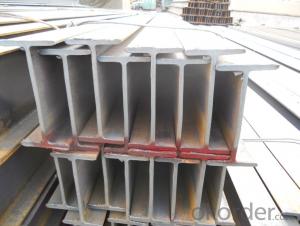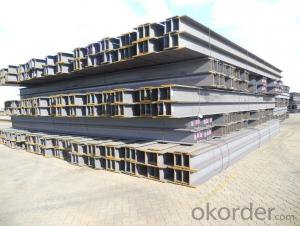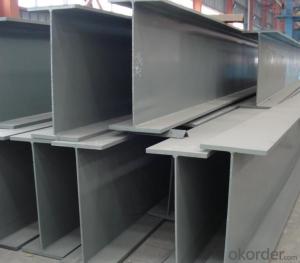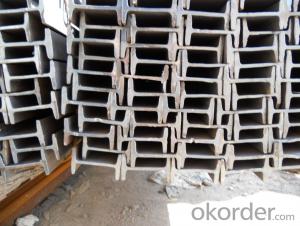H-Type Steel or H Beam Steel Section Made in China
- Loading Port:
- Tianjin
- Payment Terms:
- TT or LC
- Min Order Qty:
- 25 m.t.
- Supply Capability:
- 20000 m.t./month
OKorder Service Pledge
OKorder Financial Service
You Might Also Like
Product Description:
OKorder is offering H-Type Steel or H Beam Steel Section Made in China at great prices with worldwide shipping. Our supplier is a world-class manufacturer of steel, with our products utilized the world over. OKorder annually supplies products to European, North American and Asian markets. We provide quotations within 24 hours of receiving an inquiry and guarantee competitive prices.
Product Applications:
H-Type Steel or H Beam Steel Section Made in China are ideal for structural applications and are widely used in the construction of buildings and bridges, and the manufacturing, petrochemical, and transportation industries.
Product Advantages:
OKorder's H-Type Steel or H Beam Steel Section Made in China are durable, strong, and resist corrosion.
Main Product Features:
· Premium quality
· Prompt delivery & seaworthy packing (30 days after receiving deposit)
· Corrosion resistance
· Can be recycled and reused
· Mill test certification
· Professional Service
· Competitive pricing
Product Specifications:
1. Standard: JIS G3192 OR GB/T11263-2005
2. Grade: Q235/SS400/S235JR
3. Length: 6m-12m
4. Packing:standard export packagin
| STANDARD: JIS G3192 OR GB/T11263-2005 | |||
| H beam Section sizenma(mm) | Weight (kg/m) | ||
| Height×Breadth | Web thichness | Flange thichness | |
| 100×100 | 6 | 8 | 16.9 |
| 125×125 | 6.5 | 9 | 23.6 |
| 150×150 | 7 | 10 | 31.1 |
| 175×175 | 7.5 | 11 | 40.4 |
| 200×200 | 8 | 12 | 49.9 |
| 250×250 | 9 | 14 | 71.8 |
| 300×300 | 10 | 15 | 93.0 |
| 300×300 | 15 | 15 | 105.0 |
| 350×350 | 12 | 19 | 134.9 |
| 400×400 | 13 | 21 | 171.7 |
| 148×100 | 6 | 9 | 20.7 |
| 194×150 | 6 | 9 | 29.9 |
| 244×175 | 7 | 11 | 43.6 |
| 294×200 | 8 | 12 | 55.8 |
| 340×250 | 9 | 14 | 78.1 |
| 390×300 | 10 | 16 | 104.6 |
| 440×300 | 11 | 18 | 120.8 |
| 482×300 | 11 | 15 | 110.8 |
| 488×300 | 11 | 18 | 124.9 |
| 582×300 | 12 | 17 | 132.8 |
| 588×300 | 12 | 20 | 147.0 |
| 100×50 | 5 | 7 | 9.3 |
| 125×60 | 6 | 8 | 13.1 |
| 150×75 | 5 | 7 | 14.0 |
| 175×90 | 5 | 8 | 18.0 |
| 198×99 | 4.5 | 7 | 17.8 |
| 200×100 | 5.5 | 8 | 20.9 |
| 248×124 | 5 | 8 | 25.1 |
| 250×125 | 6 | 9 | 29.0 |
| 298×149 | 5.5 | 8 | 32.0 |
| 300×150 | 6.5 | 9 | 36.7 |
| 346×174 | 6 | 9 | 41.2 |
| 350×175 | 7 | 11 | 49.4 |
| 396×199 | 7 | 11 | 56.1 |
| 400×200 | 8 | 13 | 65.4 |
| 446×199 | 8 | 12 | 65.1 |
| 450×200 | 9 | 14 | 74.9 |
| 496×199 | 9 | 14 | 77.9 |
| 500×200 | 10 | 16 | 88.1 |
| 596×199 | 10 | 15 | 92.4 |
| 600×200 | 11 | 17 | 103.4 |
| 700×300 | 13 | 24 | 181.8 |
| 800×300 | 14 | 26 | 206.8 |
| 900×300 | 16 | 28 | 240.1 |
H beam is widely used in various building structure and engineering structure:
a).used for the plant, high-rise building construction
b).used for the bridge, shipment building
c).used for lifting and transportation machinery, equipment manufacturing base building
d).used for the support, foundation pile manufacturing
FAQ:
Q1: Why buy Materials & Equipment from OKorder.com?
A1: All products offered byOKorder.com are carefully selected from China's most reliable manufacturing enterprises. Through its ISO certifications, OKorder.com adheres to the highest standards and a commitment to supply chain safety and customer satisfaction.
Q2: How do we guarantee the quality of our products?
A2: We have established an advanced quality management system which conducts strict quality tests at every step, from raw materials to the final product. At the same time, we provide extensive follow-up service assurances as required.
Q3: How soon can we receive the product after purchase?
A3: Within three days of placing an order, we will begin production. The specific shipping date is dependent upon international and government factors, but is typically 7 to 10 workdays.
Images:

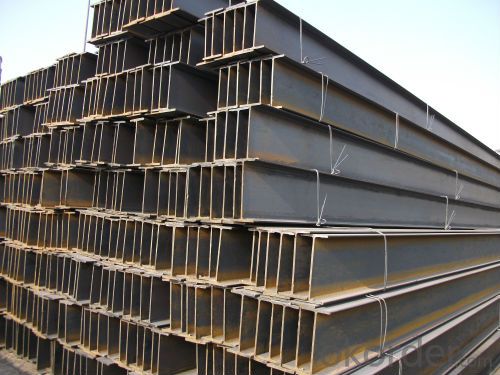
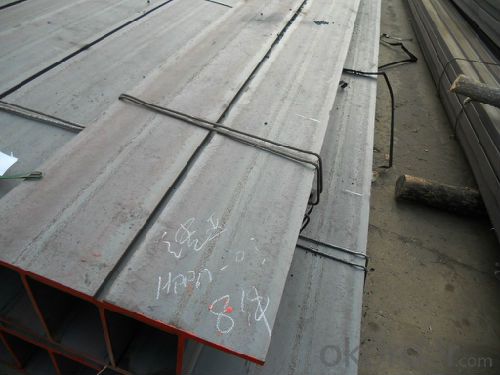
- Q:Can steel H-beams be used in sports stadiums and arenas?
- Certainly, sports stadiums and arenas can make effective use of steel H-beams. Renowned for their robustness and longevity, steel H-beams prove to be an optimal selection for substantial constructions like stadiums and arenas. They offer exceptional weight-bearing capabilities, permitting the installation of grandstands, roofs, and other vital structural components indispensable in such venues. Moreover, steel H-beams can be customized and manufactured in various dimensions and specifications, ensuring their adaptability to the distinct requirements of each sports stadium or arena project. Owing to their versatility, strength, and cost-efficiency, steel H-beams are widely favored in the construction of sports facilities worldwide.
- Q:How do steel H-beams perform in coastal areas with high salt content?
- Steel H-beams perform well in coastal areas with high salt content if they are properly protected against corrosion. The high salt content in coastal environments can accelerate the corrosion process, but with the right measures in place, steel H-beams can still provide effective structural support. One of the key factors in preventing corrosion in coastal areas is the application of protective coatings. Steel H-beams should be coated with corrosion-resistant materials such as epoxy or zinc coatings. These coatings act as a barrier between the steel and the corrosive elements in the environment, preventing direct contact and reducing the risk of corrosion. Regular inspection and maintenance are also crucial in coastal areas with high salt content. It is important to monitor the condition of the protective coatings and address any signs of damage or degradation promptly. This may involve touch-up or reapplication of the coatings to ensure continuous protection. Additionally, proper design considerations can help mitigate the effects of salt content. For example, engineers can incorporate drainage systems into the structure to prevent the accumulation of saltwater, which can increase the likelihood of corrosion. Adequate ventilation and airflow can also help to reduce the moisture levels around the steel H-beams, minimizing the risk of corrosion. It is worth noting that despite these protective measures, steel H-beams in coastal areas with high salt content may still experience some degree of corrosion over time. However, with the appropriate preventive measures and regular maintenance, the performance of steel H-beams can be significantly improved, ensuring their longevity and structural integrity in these challenging environments.
- Q:How do steel H-beams perform in high winds?
- Steel H-beams are renowned for their exceptional performance in high winds. Their structural design, featuring a broad flange and a vertical web, grants them superior strength and rigidity compared to materials like wood or concrete. Consequently, they exhibit high resistance to wind forces, ensuring stability during severe weather conditions. The H shape of the beams evenly distributes the load, minimizing wind-induced vibrations and reducing the risk of structural failure. Moreover, the vertical web provides added stiffness, enhancing their capacity to withstand lateral forces caused by high winds. Furthermore, steel H-beams can be custom-designed and manufactured to meet specific wind load requirements, making them suitable for various wind zones and regions with varying wind speeds. This flexibility allows for optimized performance in high winds, making them a reliable choice for structures in areas prone to strong gusts or hurricanes. In addition, steel is a highly durable and corrosion-resistant material, ensuring that steel H-beams remain resilient to the long-term effects of wind exposure. This characteristic guarantees their longevity and structural integrity, even under harsh wind conditions. To summarize, steel H-beams excel in high winds due to their superior strength, rigidity, and load distribution properties. Their ability to withstand wind-induced forces, combined with their durability, establishes them as a reliable choice for structures that must endure extreme weather conditions.
- Q:Can steel H-beams be used in the construction of educational institutions?
- Yes, steel H-beams can be used in the construction of educational institutions. Steel H-beams are commonly used in the construction industry due to their strength, durability, and ability to support heavy loads. They are often used as structural supports for buildings, including educational institutions, as they provide stability and allow for flexible design options.
- Q:How do steel H-beams contribute to sustainable construction practices?
- Steel H-beams contribute to sustainable construction practices in several ways. First, steel is a highly sustainable material. It is one of the most recycled materials in the world, with a recycling rate of over 90%. This means that steel H-beams can be manufactured using recycled steel, reducing the demand for virgin materials and minimizing the environmental impact of steel production. Second, steel H-beams are durable and long-lasting. They have a high strength-to-weight ratio, allowing for the construction of lighter and more efficient structures. This not only reduces the amount of steel required but also decreases the energy consumption and emissions associated with transportation and construction. Moreover, steel H-beams are versatile and can be prefabricated off-site, reducing construction waste and optimizing the use of materials. This also minimizes the disruption to the surrounding environment during the construction process. Additionally, steel H-beams provide structural stability and resistance to natural disasters, such as earthquakes and hurricanes. This ensures the safety and longevity of buildings, reducing the need for frequent repairs or reconstructions. Furthermore, steel is non-combustible, making it a safer choice for construction. It does not contribute to the spread of fire, reducing the risk of property damage and protecting human lives. Lastly, steel H-beams can be disassembled and reused in other projects, promoting circular economy principles and minimizing waste generation. This extends the lifespan of the material and reduces the demand for new steel production. In summary, steel H-beams contribute to sustainable construction practices by utilizing recycled materials, reducing energy consumption and emissions, minimizing waste, promoting safety, and supporting circular economy principles.
- Q:How do you protect steel H-beams from corrosion?
- There are multiple effective techniques available to safeguard steel H-beams against corrosion. One commonly used method involves the application of a protective coating or paint onto the beams' surface. This coating acts as a barrier, preventing moisture and other corrosive agents from coming into contact with the H-beams. It is crucial to ensure that the coating is applied evenly and thoroughly on all surfaces of the beams, including the ends and any exposed edges. Another approach is to galvanize the steel H-beams. Galvanization entails coating the steel with a layer of zinc, which provides excellent corrosion resistance. The zinc coating acts as a sacrificial layer, meaning it corrodes before the steel, thereby prolonging the H-beams' lifespan. Galvanization can be achieved through hot-dip galvanizing, where the H-beams are immersed in molten zinc, or through electro-galvanizing, which involves applying a zinc coating via an electrochemical process. Regular maintenance is also vital to protect steel H-beams against corrosion. This involves inspecting the beams for any signs of damage or rust and promptly addressing any issues. It is important to remove loose rust or scale from the beam's surface using wire brushes or abrasive pads and then apply a suitable primer or coating to prevent further corrosion in affected areas. Furthermore, ensuring proper drainage around the H-beams is crucial in preventing corrosion. The accumulation of standing water or moisture can contribute to the corrosion process. Therefore, it is essential to design and construct structures in a way that facilitates effective water drainage. Additionally, avoiding contact with other materials that may accelerate corrosion, such as certain chemicals or incompatible metals, is important in protecting the steel H-beams. In conclusion, safeguarding steel H-beams from corrosion involves a combination of preventive measures, including coating application and galvanization, regular maintenance, and proper design and construction practices. By implementing these strategies, the lifespan of steel H-beams can significantly increase, ensuring their structural integrity and durability.
- Q:What are the different bracing methods for steel H-beams?
- Steel H-beams can be braced using various methods to enhance their support and stability, particularly when exposed to heavy loads or lateral forces. One effective bracing approach involves the utilization of diagonal members, which are connected to the H-beam's flanges at different points along its length. These diagonal members play a crucial role in distributing the load and transferring forces to the vertical supports. This, in turn, enhances the overall strength and stability of the H-beam. Another method entails the use of horizontal members, which are connected to the flanges of the H-beam at regular intervals. These horizontal members prevent the H-beam from buckling or twisting when subjected to heavy loads, ensuring its rigidity and stability. Aside from diagonal and lateral bracing, there are other techniques that can be employed based on the specific requirements of the structure. Moment connections, for instance, are utilized to resist rotational forces, while shear connections facilitate the transfer of shear forces between different members. Ultimately, the choice of bracing method for steel H-beams depends on factors such as load requirements, structural design, and project conditions. By meticulously considering these factors and selecting the appropriate bracing method, engineers can effectively support steel H-beams and ensure their ability to withstand the forces they will encounter.
- Q:How do Steel H-Beams contribute to the overall occupant comfort of a building?
- Steel H-Beams contribute to the overall occupant comfort of a building in several ways. Firstly, they provide structural stability and support, ensuring that the building remains safe and secure for its occupants. H-Beams are designed to bear heavy loads and resist bending, which helps to prevent any structural issues or collapse. This, in turn, gives occupants peace of mind and a sense of security, knowing that they are in a structurally sound building. Secondly, H-Beams have a high fire resistance rating. Steel is a non-combustible material, and H-Beams are often used in fire-resistant construction systems. This means that in the event of a fire, the H-Beams can help to prevent the spread of flames and provide a safe escape route for occupants. This fire resistance translates into increased occupant comfort as it reduces the risk of injury or loss of life. Moreover, H-Beams are known for their durability and longevity. Unlike other building materials, steel is resistant to rotting, warping, and decay. This means that H-Beams will maintain their structural integrity over time, reducing the need for frequent repairs and maintenance. This stability and reliability contribute to the overall comfort of occupants by minimizing disruptions and inconveniences caused by building maintenance. In addition, the use of Steel H-Beams allows for open and flexible floor plans. H-Beams have a high strength-to-weight ratio, meaning that they can support large spans without the need for excessive columns or walls. This creates more open and spacious interiors, allowing for greater flexibility in interior design and layout. Occupants can enjoy a sense of freedom and adaptability in the use of their space, which enhances overall comfort and satisfaction. Lastly, Steel H-Beams have excellent sound insulation properties. Due to their mass and density, they can effectively block out external noise, such as traffic or construction sounds, and minimize the transmission of sound between different parts of the building. This results in a quieter and more peaceful environment for occupants, promoting a sense of tranquility and well-being. In conclusion, Steel H-Beams contribute significantly to the overall occupant comfort of a building by providing structural stability, fire resistance, durability, open floor plans, and sound insulation. Their ability to enhance safety, security, and create pleasant living or working environments ensures that occupants can enjoy a comfortable and enjoyable experience in the building.
- Q:How do steel H-beams compare to concrete beams in terms of construction speed?
- Steel H-beams are generally faster to construct compared to concrete beams. This is primarily due to the lighter weight of steel beams, which allows for easier transportation and installation. Steel beams can be prefabricated off-site, reducing on-site construction time. In contrast, concrete beams require more time for formwork, curing, and other construction processes. Overall, steel H-beams offer a quicker construction process, making them a popular choice in many construction projects.
- Q:Are steel H-beams resistant to fire?
- Yes, steel H-beams are highly resistant to fire. Due to their high melting point and excellent structural integrity, steel H-beams can withstand high temperatures and maintain their strength even during a fire. This makes them a popular choice for structural support in buildings and other fire-prone environments.
1. Manufacturer Overview |
|
|---|---|
| Location | |
| Year Established | |
| Annual Output Value | |
| Main Markets | |
| Company Certifications | |
2. Manufacturer Certificates |
|
|---|---|
| a) Certification Name | |
| Range | |
| Reference | |
| Validity Period | |
3. Manufacturer Capability |
|
|---|---|
| a)Trade Capacity | |
| Nearest Port | |
| Export Percentage | |
| No.of Employees in Trade Department | |
| Language Spoken: | |
| b)Factory Information | |
| Factory Size: | |
| No. of Production Lines | |
| Contract Manufacturing | |
| Product Price Range | |
Send your message to us
H-Type Steel or H Beam Steel Section Made in China
- Loading Port:
- Tianjin
- Payment Terms:
- TT or LC
- Min Order Qty:
- 25 m.t.
- Supply Capability:
- 20000 m.t./month
OKorder Service Pledge
OKorder Financial Service
Similar products
New products
Hot products
Hot Searches
Related keywords










